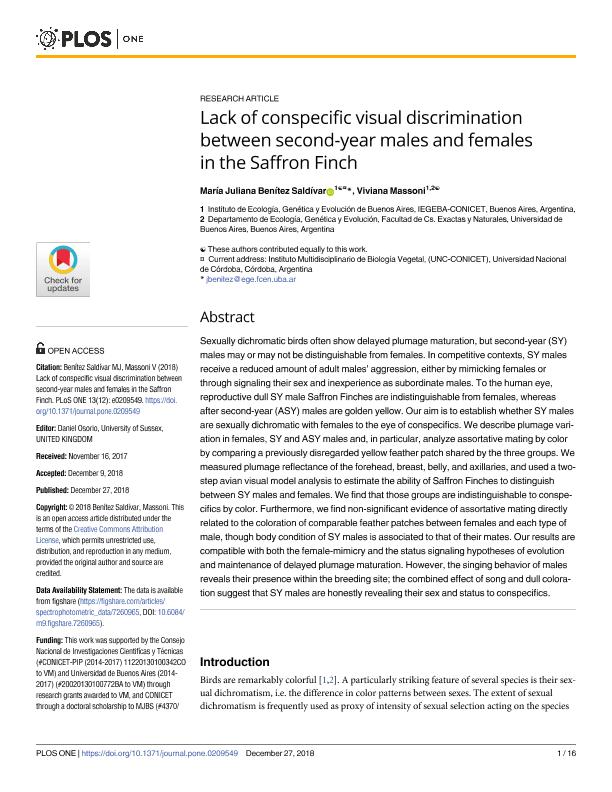Mostrar el registro sencillo del ítem
dc.contributor.author
Benitez Saldivar, Maria Juliana

dc.contributor.author
Massoni, Viviana

dc.date.available
2019-10-10T17:32:14Z
dc.date.issued
2018-12
dc.identifier.citation
Benitez Saldivar, Maria Juliana; Massoni, Viviana; Lack of conspecific visual discrimination between second-year males and females in the Saffron Finch; Public Library of Science; Plos One; 13; 12; 12-2018
dc.identifier.uri
http://hdl.handle.net/11336/85535
dc.description.abstract
Sexually dichromatic birds often show delayed plumage maturation, but second-year (SY) males may or may not be distinguishable from females. In competitive contexts, SY males receive a reduced amount of adult males’ aggression, either by mimicking females or through signaling their sex and inexperience as subordinate males. To the human eye, reproductive dull SY male Saffron Finches are indistinguishable from females, whereas after second-year (ASY) males are golden yellow. Our aim is to establish whether SY males are sexually dichromatic with females to the eye of conspecifics. We describe plumage variation in females, SY and ASY males and, in particular, analyze assortative mating by color by comparing a previously disregarded yellow feather patch shared by the three groups. We measured plumage reflectance of the forehead, breast, belly, and axillaries, and used a two-step avian visual model analysis to estimate the ability of Saffron Finches to distinguish between SY males and females. We find that those groups are indistinguishable to conspecifics by color. Furthermore, we find non-significant evidence of assortative mating directly related to the coloration of comparable feather patches between females and each type of male, though body condition of SY males is associated to that of their mates. Our results are compatible with both the female-mimicry and the status signaling hypotheses of evolution and maintenance of delayed plumage maturation. However, the singing behavior of males reveals their presence within the breeding site; the combined effect of song and dull coloration suggest that SY males are honestly revealing their sex and status to conspecifics.
dc.format
application/pdf
dc.language.iso
eng
dc.publisher
Public Library of Science

dc.rights
info:eu-repo/semantics/openAccess
dc.rights.uri
https://creativecommons.org/licenses/by-nc-sa/2.5/ar/
dc.subject
AVIAN VISUAL MODEL
dc.subject
NEOTROPICAL FINCHES
dc.subject
THRAUPIDAE
dc.subject
SICALIS FLAVEOLA PELZELNI
dc.subject.classification
Zoología, Ornitología, Entomología, Etología

dc.subject.classification
Ciencias Biológicas

dc.subject.classification
CIENCIAS NATURALES Y EXACTAS

dc.title
Lack of conspecific visual discrimination between second-year males and females in the Saffron Finch
dc.type
info:eu-repo/semantics/article
dc.type
info:ar-repo/semantics/artículo
dc.type
info:eu-repo/semantics/publishedVersion
dc.date.updated
2019-10-09T20:42:32Z
dc.identifier.eissn
1932-6203
dc.journal.volume
13
dc.journal.number
12
dc.journal.pais
Estados Unidos

dc.journal.ciudad
San Francisco
dc.description.fil
Fil: Benitez Saldivar, Maria Juliana. Universidad de Buenos Aires. Facultad de Ciencias Exactas y Naturales. Departamento de Ecología, Genética y Evolución; Argentina. Consejo Nacional de Investigaciones Científicas y Técnicas. Centro Científico Tecnológico Conicet - Córdoba. Instituto Multidisciplinario de Biología Vegetal. Universidad Nacional de Córdoba. Facultad de Ciencias Exactas Físicas y Naturales. Instituto Multidisciplinario de Biología Vegetal; Argentina
dc.description.fil
Fil: Massoni, Viviana. Universidad de Buenos Aires. Facultad de Ciencias Exactas y Naturales. Departamento de Ecología, Genética y Evolución; Argentina. Consejo Nacional de Investigaciones Científicas y Técnicas; Argentina
dc.journal.title
Plos One

dc.relation.alternativeid
info:eu-repo/semantics/altIdentifier/doi/http://dx.doi.org/10.1371/journal.pone.0209549
dc.relation.alternativeid
info:eu-repo/semantics/altIdentifier/url/https://journals.plos.org/plosone/article?id=10.1371/journal.pone.0209549
Archivos asociados
